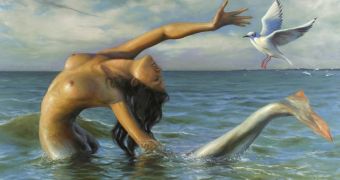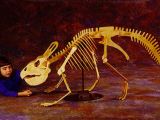Faced with some natural phenomena it could not explain, the human mind went wild and through imagination, misidentification, speculation or outright deception, fantastical mythological creatures appeared in cultures all around the world. But a new exhibition opening at the American Museum of Natural History (AMNH) this weekend, scientifically explains the possible origin of mythical creatures by means of data provided by nature, paleontology and anthropology, by combining models of mythical creatures with their lesser-known fossils or contemporaneous counterparts.
"Faced with awesome nature, our imaginations might create something to be revered, something beautiful, something to be gently feared or something simply whimsical and playful, perhaps even magical." said AMNH president Ellen Futter.
"This museum has a long history of studying and presenting great stories about the natural world and the culture of humanity. In this exhibition, we extend that tradition further, by looking at the intersection of nature and culture, those moments when people glimpse something fantastical in nature." said Futter.
When sailing around Haiti, Columbus noted in his journal he saw three mermaids, but at a closer look, the sea maidens were "not as pretty as they are depicted, for somehow in the face they look like men."
Most scientists now believe what Columbus probably saw was a manatee or sea-cow, a marine mammal related to the elephants. Their pectoral breasts, arm-like flippers and the fluke resembling a fish tail could have fooled many sailors, not just Columbus.
Visitors are greeted at the entrance by a 17-foot (5.6 m)-long, green, European dragon like the one killed by Saint George, but also a sinuous and colorful Chinese counterpart.
The myth of the dragon could be connected to crocodiles, huge monitor lizards (with their continuously moving split tongue that seems to spit fire) or huge skulls of dinosaurs. The large tentacles and the head of a giant squid (Architheutis) are beyond the shadow of a doubt the source of the myth of the kraken. At the exhibition you can touch a real narwhal tusk, which for centuries fueled the myth of the unicorn in Europe. In fact, the myth itself could have been triggered by semifossil rhino species from the Eurasian steppes which could have still survived about 1,500 years ago.
The beaked skull of a protoceratops dinosaur (the ancestor of the latter rhino-like dinosaurs), one of the fossils that practically litter the Gobi Desert even today, were mistaken for the remains of a griffin, a creature possessing the head and forelimbs of an eagle and a lion body.
Mermaids probably emerged in the minds of lonely European sailors and they spread around the world the intriguing idea of a half-woman, half-fish creature, which intermixed with local beliefs.
"People who have water goddesses, it seems when they encounter the image of the mermaid, [they find] this is a great way to represent them." said Laurel Kendall, one of the museum's anthropology curators.
The myth of the Roc, the bird that feasted on elephants, could have been based on the existence of the Aepyornis birds, which were 500 kg (1,250 pounds) heavy and 4 m (13 ft) tall, living in Madagascar and which were seen by Arab sailors.
Other mythic creatures are unknown in the western culture, like the Japanese "Kappa," a green monkey-faced creature which ate children and cucumbers. Kappas sometimes left their ponds but bowl-shaped indentations on their heads kept their power by maintaining a shallow pool of pond water. Those encountering a Kappa late at night should make a bow; if the monster bowed in turn, the water of its head spilled and the powerless creatures scurried back to its pond.

 14 DAY TRIAL //
14 DAY TRIAL // 
